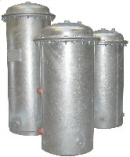Indirect Storage Cylinders
Primary Heat Source

- Steam: Steam condenses in the tube and the latent heat transfers to the stored water. The resultant condensate is at the same temperature and pressure as the steam. This can cause noise in the condensate main, as steam "flashes" off the hot condensate after a steam trap. To cure this problem a "flash coil" to condense the flash steam can be included in the cylinder if required. Steam is only suitable on helical coil units.
- Low Temperature Hot Water (LTHW): Typically 82°C flow / 71°C return. A common source of primary heat.
- Medium Temperature Hot Water (MTHW): Max. flow temperature 120°C, max. working pressure 3.4 BarG.
- Thermal Oils: These allow high temperatures at low pressure. Primary connections should be flanged and have oil-resistant gaskets. Copper degrades some oils so the tube bundle may have cupro-nickel or stainless steel tubes.
- Refrigerant: Superheated refrigerant can be cooled (and condensed if required) to heat a calorifier between compressor and condenser. A back-up system should be provided for times when the calorifier is unavailable.
- Waste Heat: If waste heat is only available at low temperatures a separate top-up heat supply will be required. We can advise on the best match of calorifier to waste heat availability and hot water demand.
- Renewable Energy: Energy generated from renewable sources can be used as a primary medium within our range of Indirect Storage Cylinders, such as energy generated from;
- Biomass Boilers
- Solar Thermal Panels
- Air Source Heat Pumps
- Ground Source Heat Pumps


